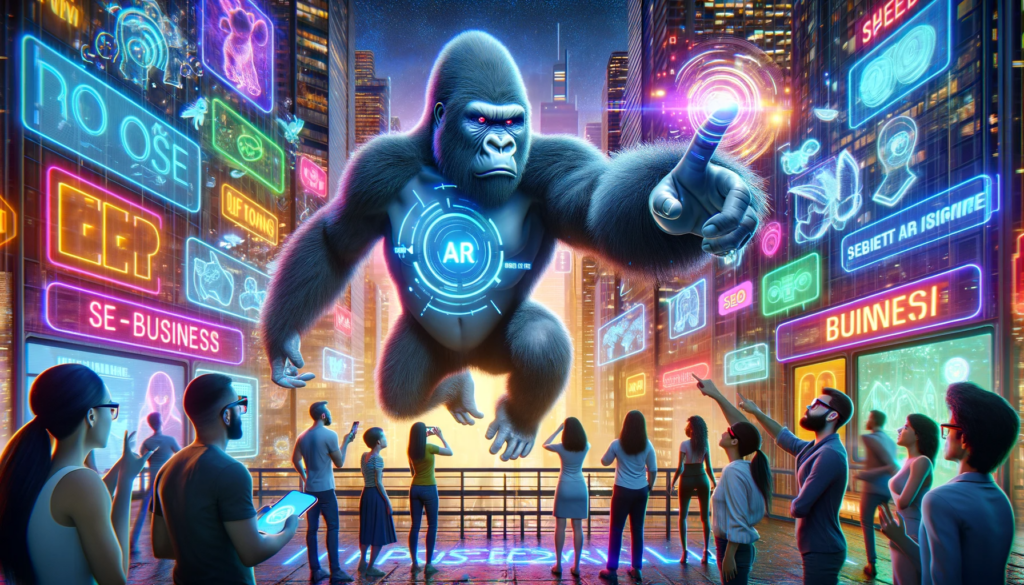What does AR do in the advertising world?
Augmented Reality (»AR«) has revolutionized the way brands interact with their audiences. By integrating digital information into the real world, AR enables advertisers to create more immersive and interactive experiences. This has not only increased consumer attention, but also led to deeper emotional connection and improved brand recall.
Suggestions and tricks:
- Use AR to »Storytelling« elements in your Advertising to integrate, which strengthens the bond with the customer.
- Remember that AR is not just a gimmick; Tools, which should offer added value for the customer.
Why is AR revolutionary in advertising?
Augmented Reality (AR) in the Advertising opens a window to a world in which digital elements are seamlessly integrated into our reality. The use of AR in the Advertising has proven to be revolutionary because it offers a whole new level of interactivity and engagement that traditional advertising formats cannot achieve. Here are some key elements that bring AR into the Advertising make it so special:
- Interactive experience: AR allows consumers to interact with the Advertising to interact in ways that go far beyond just looking. This creates a unique and personal experience that strengthens brand loyalty.
- Increased memory: Thanks to the immersive experience of AR, the advertising message remains longer and clearer in consumers' minds. A tip: Use AR to create a History to tell a story that anchors your brand in the minds of your target group.
- Personalization: AR provides tailored experiences tailored to users' individual preferences and interests. This increases the relevance and effectiveness of your advertising messages.
- Measurable results: The interactivity of AR allows you to have detailed data collect about user engagement. This information is crucial for the Optimization of future campaigns.
- Unlimited creativity: AR opens up unlimited creative possibilities to put your brand at the forefront. Whether it's an interactive gaming environment or a virtual product demonstration, AR makes it possible.
How does AR work in different forms of advertising?
AR advertising can be implemented in a variety of formats, each with its own specific features and areas of application:
- AR in print advertising:
- Application: Inclusion of AR elements in magazines, brochures or posters.
- Function: By scanning the printed ones Advertising An AR app displays additional content such as videos or 3D models.
- Tip: Use AR to capture static Pictures to bring it to life and offer additional product information.
- AR in digital advertising:
- Application: Use in social media, websites and mobile apps.
- Function: Interactive ads that change or adapt based on user interaction.
- Tip: Incorporate gamification elements to increase user interaction and engagement.
- AR in outdoor advertising:
- Application: Large advertising boards, bus stops or shop fronts.
- Function: Using AR to provide passersby with an immersive experience.
- Tip: Create surprising and memorable experiences that passersby will share in social networks stimulate.
- AR in event marketing:
- Application: trade fairs, conferences or pop-up events.
- Function: Visitors can interact interactively via AR apps Content discover that relate to the environment.
- Tip: Offer exclusive content or discounts only accessible via AR to make visiting your booth more attractive.
Due to the variety of possible applications, AR is a flexible and powerful tool in the advertising world. The key is to use AR technology creatively and purposefully to achieve maximum impact.
Why is AR indispensable in advertising?

Augmented Reality (“AR”) in advertising offers companies unique opportunities to strengthen their brand presence and communicate effectively with their target group. By using AR, companies can create a deeper emotional connection with consumers, improve the efficiency of their advertising spend, their Turnover increase and make hyperlocal advertising strategies more effective.
How does AR strengthen emotional customer loyalty?
- Immersive experiences: AR creates unique, immersive advertising experiences that engage customers on an emotional level.
- Interactive content: Through interactive elements such as games or 3D experiences, customers are actively involved in the advertising message, which increases brand recall and loyalty.
- Realistic representation: AR enables products and services to be presented in a realistic way Kontext represent, which intensifies customer loyalty.
Tips and Tricks:
- Use AR to tell stories around your products to create a deeper emotional connection with consumers.
- Incorporate interactive elements into your AR advertising to increase customer engagement.
Why are AR ads cost effective?
- Lower production costs: Compared to traditional advertising methods, AR ads can often be produced more cost-effectively, especially when digital content can be reused or easily updated.
- Targeted delivery: AR enables more precise and targeted advertising campaigns, reducing wastage and increasing the efficiency of advertising spend.
- Longer engagement times: AR content tends to engage users for longer, increasing the effectiveness of any advertising investment.
Tips and Tricks:
- Use existing digital content and adapt it for AR applications to save costs.
- Rely on targeted AR campaigns to minimize wastage and ROI to maximize.
How does AR promote increased sales?
- Increased Engagement: AR applications increase customer engagement and can therefore lead to higher conversion rates.
- Virtual Try-Ons: Through functions such as virtual trying on of products customers make a better purchase decision, which increases the likelihood of completing the purchase.
- Improved product display: The realistic representation of products in AR applications can increase the attractiveness of the offer and thus boost sales.
Tips and Tricks:
- Develop AR applications that give customers a realistic idea of the Products to make the purchase decision easier.
- Use Virtual Try-Ons to improve the shopping experience and increase conversion rates.
What impact does AR have on hyperlocal advertising?
- Localized content: AR allows companies to offer hyperlocal advertising content tailored to the user's location and context.
- Location-related offers: AR makes it possible to provide users with location-based offers and information in real time.
- Increased relevance: Hyperlocal AR ads are often more relevant to the user, increasing the likelihood of a positive response.
Tips and Tricks:
- Use geolocation data to develop hyperlocal AR advertising campaigns that are relevant to users in their current context.
- Make sure your AR applications provide users with useful and timely information based on their location.
Through these methods, companies can make optimal use of the advantages of AR in advertising and structure their marketing activities efficiently.
How is AR used in real advertising campaigns?
Augmented Reality (»AR«) has established itself as a versatile and effective tool in the advertising world. Various industries and brands have used AR in creative ways to create unique and interactive advertising campaigns that increase both attention and engagement among target audiences. Here are some outstanding examples of the practical use of AR in advertising.
What did IKEA's AR campaign achieve?
- Interactive catalogs: IKEA used AR to bring its catalog to life. Customers were able to virtually place furniture in their own living spaces using the IKEA app.
- Increased customer experience: This technique allowed customers to get a better idea of how the products would look in their home.
- Result: The AR campaign resulted in improved customer satisfaction and an increase in online orders.
Tips and Tricks:
- Use AR to give your customers a realistic preview of your products in their living space.
- Make your AR application user-friendly and intuitive to ensure wider adoption.
How did Pepsi revolutionize bus shelter advertising?
- Interactive bus stops: Pepsi used AR to transform everyday bus stops into exciting and interactive experiences.
- Vivid Ads: By installing screens that combined real scenes with virtual elements, Pepsi created surprising and entertaining moments for those waiting.
- Result: This campaign achieved high virality and strengthened Pepsi's brand image as an innovative and creative company.
Tips and Tricks:
- Use AR to transform everyday situations into extraordinary experiences.
- Remember that surprise and Entertainment are powerful tools to attract attention.
How did Toys “R” Us engage kids with AR?
- Interactive store experiences: Toys “R” Us ran an AR campaign that engaged children in a virtual Easter bunny hunt in the store.
- Playful learning: Children used tablets to hunt virtual bunnies and collect eggs that were converted into discounts on toys.
- Result: This campaign not only increased store traffic but also created a fun and educational experience for children.
Tips and Tricks:
- Develop AR experiences that combine fun and education to appeal to both children and parents.
- Make sure your AR experiences are age-appropriate and safe.
How did Lacoste change the shoe shopping experience?
- Virtual fittings: Lacoste developed an AR app that allowed customers to try on shoes virtually.
- Increased purchase decision: This technology helped customers get a better idea of how the shoes would look on their feet.
- Result: The AR application improved customer experience and increased online sales.
Tips and Tricks:
- Use AR to give your customers a realistic idea of your products, especially if they are sold online.
- Make sure your AR app offers high image quality to create the most realistic experience possible.
What did Net-A-Porter achieve with AR storefronts?
- Digitized shop windows: Net-A-Porter used AR to transform its storefronts into interactive displays.
- Extended information: Customers were able to access additional product information, pricing and 360-degree views using their mobile devices.
- Result: This campaign resulted in increased customer engagement and strengthened the brand image as an innovative retailer.
Tips and Tricks:
- Use AR to add a digital touch to your physical storefront and enhance the customer experience.
- Make sure your AR storefronts are easy to use and relevant Content Offer.
Using AR can create interactive and memorable customer experiences that simultaneously increase sales and brand loyalty.
What hurdles are there with AR in advertising?

The implementation of augmented reality (»AR«) in advertising offers numerous advantages, but also brings with it specific challenges. These range from the need to develop mobile applications to hardware limitations to complex development processes. A deep understanding of these challenges is crucial to designing effective and engaging AR advertising campaigns.
Why is a mobile app necessary for AR advertising?
- Accessibility: For most AR experiences there is one mobile devices Application required so that users can experience the AR content on their smartphones or tablets.
- Development effort: Developing a user-friendly and powerful app can be time-consuming and costly.
- User acceptance: The challenge is to get users to download and install an additional app.
Tips and Tricks:
- Integrate AR functions into existing apps to lower the inhibition threshold for users.
- Offer clear value that motivates users to download the app and use it regularly.
What are the hardware limitations of AR?
- Performance of the devices: The quality of AR experiences depends heavily on the performance of the devices used.
- Graphical representation: High-quality AR experiences require advanced graphics processing that not all devices support.
- Availability: Not all target groups have the latest smartphones or tablets required for sophisticated AR experiences.
Tips and Tricks:
- Optimize your AR applications for a wide range of devices to reach a larger user base.
- Test the Performance of your AR applications on different devices to ensure they work consistently.
What is the development process of AR advertising like?
- Complexity: The Development AR advertising requires an understanding of both technical and creative aspects.
- Resources: Specialized skills are often required for development Tools required that are not available in every company.
- Time and cost expenditure: The Development can be time-consuming and costly, especially for demanding projects.
Tips and Tricks:
- Consider working with specialized AR development studios to achieve high-quality results.
- Plan enough time and budget for development, taking both technical and creative aspects into account.
These challenges show that the successful Implementation AR in advertising requires careful planning, resource allocation and technical expertise. With the right one Strategy and implementation, these hurdles can be overcome and successful AR advertising campaigns can be realized.
What are the future trends for AR in advertising?
Augmented Reality (»AR«) is constantly developing and forming new ones Trends in the advertising industry. Future developments show great potential for integrating AR into hybrid customer experiences, combining AR and Artificial intelligence ("AI«), the personalization of advertising content and the development of user-friendly AR applications for consumers. This Trends will fundamentally change the way brands interact with their customers.
How is AR integrated into hybrid customer experiences?
- Linking online and offline: The future sees a greater fusion of digital and physical customer experiences, with AR playing a key role.
- Advanced Store Experiences: For example, customers could use AR in stores to receive additional product information or personalized recommendations.
- Event marketing: AR could be used at events to create interactive and immersive experiences.
Tips and Tricks:
- Consider how AR can enrich the customer experience in your physical store or at events.
- Ensure your AR experiences are seamlessly integrated into the existing customer journey.
What role does the combination of AR and AI play?
- Smart personalization: The combination of AR and AI enables advanced personalization of advertising content by analyzing user data and delivering relevant content in real time.
- Improved user interaction: AI can understand and adapt user behavior and preferences to enhance the AR experience optimize.
- Automated content development: AI can help automate the creation of AR content to create dynamic and engaging advertising experiences.
Tips and Tricks:
- Use AI to increase the relevance and effectiveness of your AR advertising campaigns.
- Use data-driven approaches to develop personalized AR experiences.
How does AR contribute to personalization?
- Tailored Experiences: AR makes it possible to tailor advertising content to individual user needs and preferences.
- Interactive product demonstrations: Customers would be able to see and experience products in a personalized context, leading to higher engagement rates.
- Targeted advertising messages: By using user data, AR ads can be tailored specifically to the interests and needs of the target group.
Tips and Tricks:
- Collect and analyze customer data to create personalized AR advertising content.
- Make sure your personalized AR experiences Privacy and respect user preferences.
How is AR application development evolving?
- User friendliness: The future demands AR applications that are easy to use and offer a seamless user experience.
- Cross-platform solutions: Developers are striving to create AR applications that work across different devices and platforms.
- Interactive and immersive content: AR applications are expected to increasingly offer interactive and immersive content that deeply engages users.
Tips and Tricks:
- Focus on developing AR applications that are easy to use and work on various devices.
- Experiment with new forms of interactive and immersive content to engage users.
This Trends show that AR will continue to gain traction in advertising by offering innovative ways to enrich customer experiences and deepen the interaction between brand and consumer.





